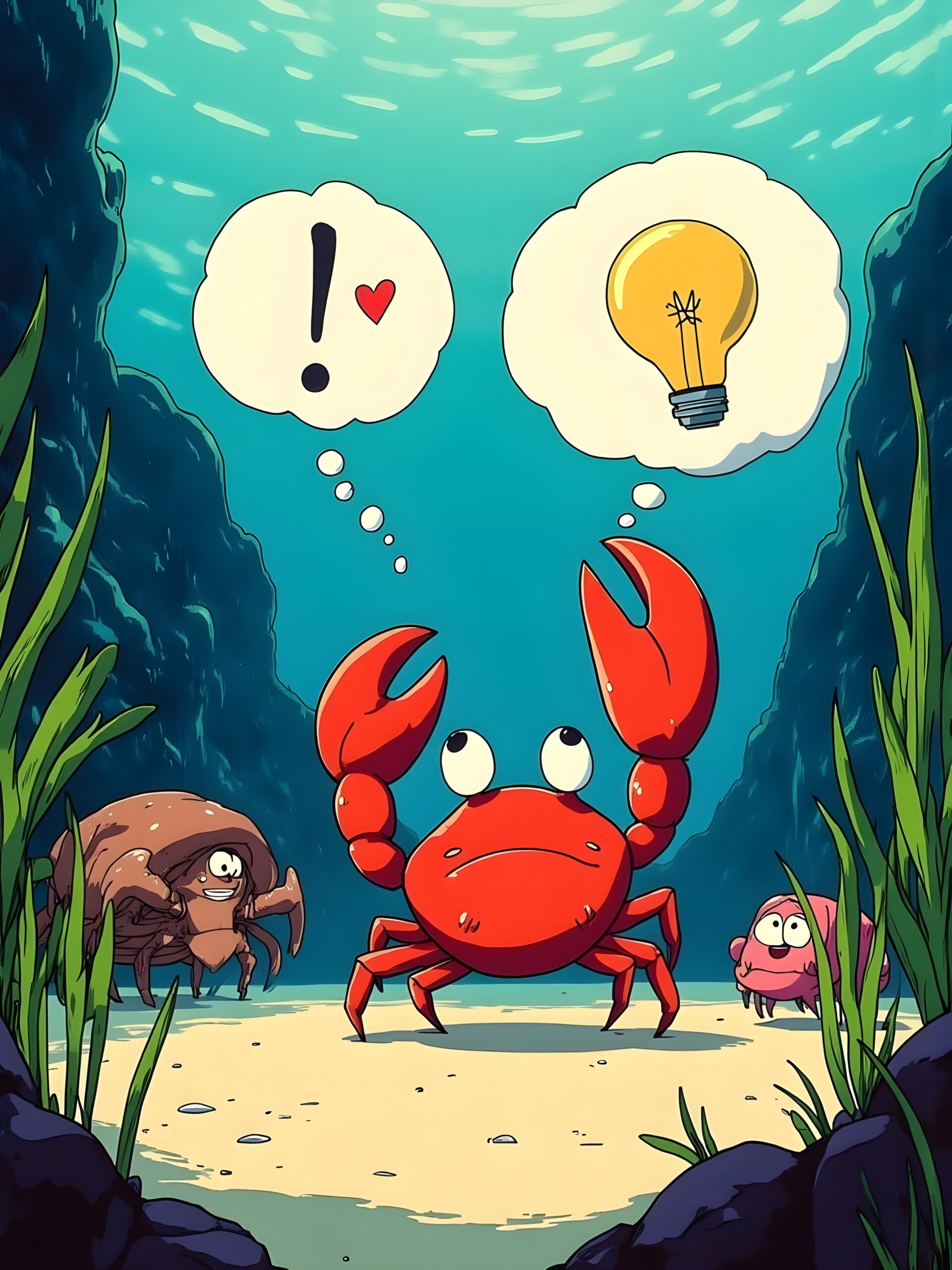Part of our job as teachers and parents is to help kids realize that they are not the centre of the whole world. We need to get them out of their bubble and into the bigger picture of society where one respects and collaborates with others. But “telling” what is right brings little effect. Tell and they will forget. Let them see and they will remember some. Get them to do and they will understand. As Paul Zak, Director of the Centre of Neuroeconomics Studies at Claremont Graduate University says: “Stories capture our attention better than other information and leave a physical & emotional trace in the brain”. Stories indeed help us take our message a step further especially when we retell or role play or act them out.
------------------------------------------------------------------------------------------------------------------
Our protagonist in this undersea adventure is Baby Crab and the other characters are Mother Crab, Octopus, Clam, Flat fish and Squid. Our story happens at the bottom of the sea where Mother Crab and Baby Crab live happily protected behind a big rock. It is a day, like any other day except that on that day little Crab comes out of the big rock and looks around. He is curious and sees other fish swim by and wants to find more of what is out there. He turns to his mum and says:
“Mummy, mummy I want to go out by myself”.
Mummy tells him to be patient and soon he will do so. But he keeps asking and begging and repeating the same thing and a few days later Mother Crab says:
“Perhaps it is alright for you to go out alone. I see that your pincers have grown quite strong. But be careful with your pincers. Be a good little crab”.
“Yes, mummy I will be a good little crab’ he promises and click, clack, click clack, he ventures out.
Not too far, Young Crab sees some fish and he wants to play with them but he does not know how. He also wants to see how his pincers work. Little Crab has seen how mum used them to get food, protect herself and scare away whoever came too close. Baby Crab wonders if he can do the same with his pincers. He opens and closes them as he swims close to the other fish. And click, clack, click, clack he goes near the other fish who get scared and move back shouting “Do not be such a bully”. The little Crab likes the attention and continues with his click, clack, click clack. Little Crab likes being noticed and wonders what else he can do with his Pincers. He comes across some seaweed and the idea hits him. He goes click, clack, click clack and snips away the seagrass. But an unhappy Clam comes out from under the sand comes and asks angrily:
“Who is that cutting all our sea grass? Our seaweeds are very important to us”. Baby crab does not stop and the Clam says “we need the seaweed. Stop what you are doing. Don't be a naughty, spoilt little crab”, to which baby Crab replies:
“Don’t call me naughty. I am only playing”
“Destroying is not playing. Stop being naughty crab”.
“If you call me naughty, I will sting you with my claws” replies the crab.
“Are you then? Come and get me” replies the Clam and so little Crab bends over and gets hold of the Clam who shuts himself in his hard shell and is well protected. Little Crab squeezes the Clam hard to break the shell. But it is hard and tight. He cannot break it.
“I think I think I will leave you. I am going to break my claws with your hard shell”. He says and the Clam advises him to let go off him before he hurts himself. The little Crab lets go off the Clam and swims away fast and far and doesn’t see where he is going.
A little later young Crab sees Mr. Squid and wonders what will happen if he stings him. Without giving it a second thought, Little Crab pinches Mr Squid who shouts out in pain from the jab. Mr Squid furiously gives a whoosh sound and sends out a cloud of black ink which blinds the little crab who cannot see anything. Frightened, little Crab moves backwards and backwards to escape from the black ink and suddenly lands in a net that a fisherman has thrown.
Poor little Crab is trapped in the net. He pulls, grasps, snatches, claws at the net to tear it, to crush it, to snap it. Little Crab pushes and pulls and struggles to crawl out of the holes in the net but he is not small enough to do so. Just then Mrs flat fish swims over and little crab shouts for help. Mrs Flatfish replies:
“I'm so sorry I cannot help you or all the other fishes stuck in there. But you can get out if you use your pincers. Little Crab keep trying to cut the net and you will do it. Keep trying”
So, click, clack, click, clack little Crab tries hard to cut the ropes and the cords of his trap. And the Flat fish keeps encouraging not to give up. And you will not believe it but after a lot of click, clacks, click, clacks, Little Crab cuts the tough cords of the net and opens a hole and continues cutting and manages to make a bigger hole and soon all the fishes manage to swim out.
There are many “hoorays” and the other fish are very grateful to the little Crab. They thank him and Little Crab is happy and proud too. But he is mixed. Now he understands that he can use his pincers for good; not for naughty things. And he wants to go back home to mummy Crab and tell her what happened, how frightened he was and what he has learned. And when mum Crab hears it all she says that “mistakes are good if they teach us what to avoid in future”.
Stories for Social and emotional learning?
Certainly. Stories are mystery boxes which seize attention and engage us in a non-stressed state of interest. They create positive learning environments and provide us with emotional and language support to better express ideas and feelings. After all this is why communities have always used this longest established oral art form. Through stories we recognise the many shades of emotions. We share experiences, hopes or fears and we build personalised relationships of trust. In this story little Crab becomes more society ready after his adventure because he understands himself better and knows better where he belongs.
After telling activities. Freeze picture
One effective drama game is to isolate one or more scenes from the story and ask students to use their body posture, hands, feet and face expressions to represent the scene in a Still frame. Still frames or else Freeze pictures are fun activities which break the shy barrier and remove inhibitions. Students can recreate the scene of the trapped fish in a freeze frame with one student being the crab and the others being the fish caught in the net. The scene is not expressed orally but bodily. Hesitant learners, in particular, appear to unlock imagination, visualise the story and allow unexpected, embodied self-expression. A variation of the Freeze frame game is for a group to do a freeze frame and the other groups to guess the scene.
Retell, reframe or change the course of events.
Inspire students to re-tell the story, or act out scenes of it according to the roles you have assigned. This will help them explore their expressiveness and communicate thoughts & feelings in a safe and supportive environment. Encourage the use of visuals because they help those who are not confident and do not trust their memory. Props, masks, puppets and realia break inhibitions and liven retelling of stories.
Reframe the story through “what if” questions. “What if” the flat fish hadn’t advised the crab to use his pincers? Or “What if” the crab had not used his pincers in the way he did and instead made friends with the other fish from the start?
The cause is the reason. The effect is the result
Ask students to spot the result that each action brings in the story.
| Little Crab goes click clack, click, clack | The fish get scared away |
| The Crab cuts the seaweed. | The Clam comes out and tells him off |
| The Crab annoys the Squid. | The squid sends out black to blind him |
| The Crab moves without care. | He is caught in a trap |
Talking points
Ask students to summarize the story and use pictures of the scenes to make things easier. Talk about the characters, what they said or did. Here are some talking points.
ex: Why did the Crab immediately run back to his mum when he got out of the trap?
ex: How did this adventure help the Crab understand his own feelings better?
ex: Why do we think that the Crab will be wiser in the future?
ex: Do mistakes usually teach us to regulate our thoughts and actions?
.
The message the story leaves us with
The message is personal but revolves around the fact that mistakes bring about self-discovery because we learn from them. They are less painful when they help us correct our attitude. They can help us be more responsible, take caring decisions, develop healthy identities and adopt proper attitudes. Also we should use our strength for good causes.
Zafi Mandali holds a BA in English Language & Literature, Aristotle University of Thessaloniki and an M.A. in Applied Linguistics, University of Essex. Retired from Director of studies, Department of English, Ellinogermaniki Agogi, she works as an active educator, teacher trainer, storytelling coach, educational consultant and serves on the Tesol Greece Board. She is a presenter, article contributor, published author of four E.A. Publications. Her soft point is Storytelling in Education with samples of work uploaded on www.eltstorytelling.com and Eltstorytelling facebook group.

